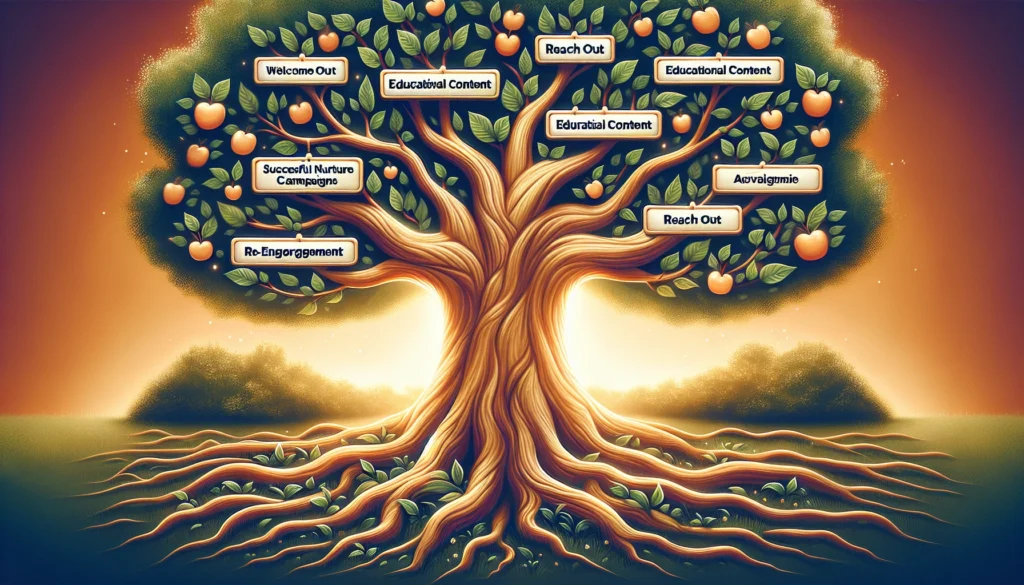Table of Contents[Hide][Show]
What makes a nurturing campaign drive your leads down the sales funnel successfully? Focused on dynamic engagement rather than a one-size-fits-all approach, nurture campaigns tailor the digital marketing experience to individuals, accelerating their journey to conversion. Creating quality content for email marketing campaigns is crucial, as it helps engage leads through personalized content, lead-nurturing emails, and drip marketing campaigns. This article dives into the key strategies that define a successful nurture campaign, from personalization and timing to advanced techniques like segmentation and behavioral triggers. Expect to gain actionable insights to enhance your connections with and convert your leads.
Key Takeaways
Nurture campaigns provide tailored engagement to lead through dynamic content delivery based on behavior. They offer a more personalized approach than standard drip email campaigns, accelerate the sales cycle, and build trust.
Lead nurturing success hinges on crafting compelling emails with engaging subject lines, relevant and concise content personalized to each audience segment, and timely delivery leveraging automation.
Automation plays a pivotal role in nurturing campaigns, managing email sequences, activating behavioral triggers, and providing a multichannel approach for consistent customer experiences across email, social media, and sales calls.
Understanding Nurture Campaigns: The Basics

Nurture campaigns are more than just emails sent to potential customers. They’re a strategic approach to building relationships and guiding leads toward a purchase. During the campaign creation process, it’s essential to understand that, unlike standard drip campaigns that send out messages at specific intervals, nurture campaigns are dynamic and adjust to each individual lead’s behavior and engagement level. This ensures the right content and timing, making the lead feel valued and understood.
An email nurture campaign is a series of targeted emails based on a lead’s behavior, aimed at providing timely, relevant information to guide the lead through the buying process.
This level of personalization is what makes nurture campaigns stand out, and ultimately, what leads to their success.
Defining a Nurturing Campaign
A nurture campaign involves a series of communications aimed at building a relationship between a business and a potential customer. These communications are tailored to individuals who have shown interest in the business’s offerings. An email nurture campaign delivers educational value while encouraging engagement and personalized communication, with the goal of fostering relationships and converting promising leads into loyal customers. This goal is not to make a quick sale, but to build a relationship with the potential customer and gradually guide them towards making a purchase.
This involves understanding the buyer persona and tailoring the campaign to effectively engage with them.
The Core Objectives of Nurture Campaigns
Nurture campaigns have several core objectives. They aim to:
Accelerate the sales cycle by providing personalized communications that address the leads’ specific needs and pain points
Build trust, which increases the likelihood of converting leads into customers
Consider the prospective buyers’ pain points, specific industry or segment, and ideal client profiles, among other factors
Interestingly, leads that go through the nurture email process are 50% more sales-ready compared to those that don’t, highlighting the educational role of nurture campaigns.
Nurture vs. Drip: Spotting the Difference
While both nurture and drip campaigns aim at guiding leads through the sales funnel, they do it in different ways. These campaigns are personalized and triggered by lead behavior, whereas drip campaigns are time-based and initiated by specific actions, such as signing up. This makes nurture campaigns more dynamic and effective in building long-term relationships with leads. They offer specific content to specific contacts at specific times, based on lead activity.
This personalized approach is in contrast to the less personalized, scheduled emails of drip campaigns.
Crafting a Compelling Lead Nurturing Email

The success of a lead nurturing campaign greatly depends on the quality of the nurturing emails. Crafting high-performing lead nurturing emails is essential as they drastically increase the chances of leads becoming customers. These emails should be tailored to the audience’s needs and expectations to establish deeper connections. To further enhance your results you should consider aligning your nurturing emails with the buyer’s journey (Awareness, Consideration, Decision) to warm your prospects over time. Email marketing plays a crucial role in creating quality content for lead nurturing emails, ensuring that each message provides value and engages leads effectively.
From crafting an attention-grabbing headline or subject line to providing insightful content related to the industry or product, every element of the email should be designed to engage the lead and guide them towards making a purchase.
The Art of the Subject Line
The subject line needs to generate open rates, as it is the first thing that the recipient sees, and it can greatly influence whether or not they open your email. A creative and intriguing subject line will pique the recipient’s interest and increase the chances of your email being opened.
The subject line should be designed to grab the recipient’s attention instantly, perhaps through personalization or by posing a compelling question. It should also be mobile-friendly and succinct, addressing the interests specific to each lead’s segment.
Content That Connects
Once your email is opened, the content should connect with the recipient on a deeper level. This involves addressing customer pain points and offering solutions, which helps to build relationships. Make sure your content is:
helpful and succinct
include calls to action
be visually pleasing
avoid long-winded explanations
Email marketing can play a crucial role in providing valuable knowledge through educational email courses. Segmenting your audience also enables you to personalize your content and make it more effective.
Personalization and Timing
Personalization and timing play a crucial role in the effectiveness of lead nurturing emails. Implementing a well-crafted lead nurturing email sequence can enhance these aspects. Some tips for creating personalized email sequences include:
Using automation software to tailor content to individual recipients’ needs, interests, or behaviors
Segmenting your email list based on different criteria, such as demographics or past interactions
Sending targeted emails based on specific actions or behaviors, such as abandoned cart reminders or product recommendations
By implementing these strategies, you can improve engagement and response rates for your lead nurturing emails.
Ideally re-engagement emails are triggered by certain actions of the lead, such as abandoning a cart, to maintain engagement until they are ready to purchase. By personalizing content according to the lead’s needs, interests, industry, and company size, engagement is increased and trust is built.
The Role of Automation in Nurturing Campaigns

Marketing Automation platforms like Hubspot plays a crucial role in managing and personalizing nurture campaigns. Marketing automation software is recommended for nurturing leads and automating outreach based on lead engagement, facilitating personalized and professional communication. Additionally, email marketing tools can automate and personalize nurture campaigns, ensuring that the right content reaches the right audience at the right time.
Automated systems can:
Assess the optimal timing for sending emails
Manage the sequence by analyzing leads’ behavior
Increase the visibility and engagement of the emails sent to potential customers
Automation tools also provide valuable data that can be used to refine lead nurturing efforts.
Streamlining the Email Sequence
You can easily create and manage email sequences using marketing automation platforms. These platforms offer automation features that facilitate the creation and management of email sequences, enabling businesses to deliver personalized content efficiently. Integrating marketing automation platforms with lead management systems leads to enhanced efficiency and collaboration through centralized tracking and data synchronization.
Automated systems also have the capability to send emails according to recipients’ time zones, ensuring messages are received at the most opportune times.
Behavioral Triggers and Personalized Paths
Automation in nurture campaigns allows for personalization based on the lead’s behavior. For instance, following a lead’s action, such as filling out a contact form, triggers automatically added to a segmented list that begins an email campaign based on their behavior. This creates a personalized path for the lead, increasing the likelihood of a purchase.
Welcome emails play a pivotal role in these campaigns by warming up leads and increasing the chances of making a purchase.
Multi-Channel Approach to Nurturing Leads

Adopting a multi-channel approach in nurturing leads can greatly enhance customer satisfaction and retention. This involves delivering consistent experiences across various communication channels. By implementing omnichannel marketing, you can meet customer expectations at each interaction, increasing customer loyalty and boosting their lifetime value to the business. Email marketing is a key component of this approach, providing personalized content through email campaigns, lead nurturing emails, and drip marketing campaigns.
Consistent messaging and experiences are vital in multichannel nurturing to strengthen relationships across different platforms including email, social networks, SMS, chatbots, and phone calls.
Beyond Email: Incorporating Social Media
While email remains a powerful tool in nurturing leads, social media platforms also offer a great opportunity to engage with potential customers. Some ways to enhance social media engagement include:
Using interactive content such as polls and quizzes
Encouraging user-generated content
Utilizing chatbots for faster and more personalized engagement with potential customers.
By maintaining a consistent message and voice across all marketing channels, including social media, you can capture and keep customer interest.
Leveraging Content Marketing
Content marketing plays a significant role in nurturing leads. By offering valuable content, you can:
Provide helpful information to your leads
Position yourself as a credible authority in your field
Share insider advice
Publish relevant industry news
This is done through various forms of content, such as blog posts, articles, videos, and podcasts.
To illustrate this point, consider the company Casper, which provides informative content about sleep hygiene in their nurturing emails, providing value beyond just selling products.
Direct Engagement Through Sales Calls
Although digital nurturing efforts are important, direct engagement through sales calls remains a crucial aspect of nurturing leads. Sales calls complement digital efforts by:
Fostering personal connections with leads
Providing an opportunity for real-time conversation and clarification
Building trust and rapport
Addressing specific concerns or objections
Offering personalized solutions and recommendations
This personal touch can often be the deciding factor for leads when choosing between different companies offering similar products or services.
Anatomy of Successful Nurturing Campaigns

Successful nurture campaigns have a few things in common. They all involve the use of welcome emails, educational content, and re-engagement strategies. Regularly measuring, reviewing, and adjusting these campaigns based on customer feedback is also crucial to ensure the message resonates and the approach remains effective. An email nurture campaign, which is a series of targeted emails based on a lead’s behavior, is a key component of successful nurture campaigns. It focuses on delivering educational value and personalized communication to foster relationships and convert promising leads into loyal customers.
In fact, an effective lead nurturing strategy can have a significant impact on annual revenue, potentially resulting in substantial increases.
Welcome Emails: Just the Beginning
The first step in a successful nurturing campaign is sending a welcome email. This email sets the initial tone for the campaign, leading to customer loyalty.
The initial welcome email:
Establishes the first impression
Sets the tone for future communication with new leads
Lays the groundwork for ongoing nurture efforts that foster long-term loyalty.
Educating Leads: Content as a Tool
Educational content is another key component of successful nurturing campaigns. This type of content helps in the early stages of the buyer’s journey where potential customers are seeking information. By providing educational content, you:
Establish your company’s credibility
Position yourself as an authoritative resource in your field
Pique the interest of your leads
Foster trust, making them more likely to choose your company when they’re ready to make a purchase.
Re-Engagement Campaigns: Reviving Interest
Even with the best nurturing strategies, some leads may become inactive or disengaged. This is where re-engagement campaigns come in. These campaigns aim to rekindle interest among these leads using compelling offers or new insights.
Re-engagement strategies involve using a multi-touch approach with educational content and follow-up calls to rekindle interest among leads that have not been actively engaged by sales teams for a period of time.
Aligning Sales and Marketing Teams for Synergy
Another crucial aspect of successful nurturing campaigns is the alignment of sales and marketing teams. When these two teams are aligned, there can be a significant increase in business growth. This can be achieved through unified sales messaging, which contributes to a consistent approach in nurturing campaigns.
Regular collaboration between these teams is necessary to enhance the effectiveness of nurturing strategies. Sharing insights and data assists in creating and adjusting lead scoring strategies to better reflect customers’ behaviors and conversion paths.
Unified Messaging Across Teams
Having a unified message across all teams is crucial for capturing and keeping customer interest. A successful multichannel strategy ensures that the brand messaging is uniform across various marketing campaigns and channels. Consistent branding in lead nurturing emails is important for representing the business image, voice, and brand. It helps build trust and brand loyalty.
Establishing a clear and pre-approved message for sales scenarios ensures consistency of communication across the teams.
Sharing Insights and Data
Sharing insights and data between teams is crucial for the success of nurturing campaigns. This helps in creating and adjusting lead scoring strategies to better reflect customers’ behaviors and conversion paths. Continuous iteration and alignment of data and strategies between teams improve lead qualification and the nurturing process.
Regular collaboration between sales and marketing teams is necessary to enhance the effectiveness of nurturing strategies.
Measuring the Impact of Your Nurture Campaigns
Just like with any other marketing strategy, it’s important to measure the impact of your nurture campaigns. This involves tracking key performance indicators, assessing the return on investment, and conducting A/B testing. Automation platforms can enhance the measurement of campaign impact through advanced reporting and analytics features, which help track the success and guide improvements for email sequences.
Regular analysis of lead lifecycle and performance data is essential to identify areas of improvement and to optimize for better lead conversion rates.
Key Performance Indicators (KPIs) to Watch
There are several KPIs that you should monitor in a nurture campaign. These include engagement rates, revenue impact, and results from A/B testing. The return on investment (ROI) is a key metric that evaluates the profitability generated by investments in nurturing campaigns.
Open and click-through rates are used to ascertain the level of effectiveness within a nurture campaign’s email engagement. It’s also interesting to note that nurtured leads become 50% more sales-ready, and welcome emails contribute to higher revenue growth and are more cost-effective compared to other marketing strategies.
The Power of A/B Testing
A/B testing is a method used to compare two versions of email content to determine which one performs better. It’s a powerful tool that can give you insights into the preferences of your audience, leading to improved email engagement and higher conversion rates. Elements such as:
subject lines
email copy
call-to-action buttons
send times
Testing different strategies can help optimize both email campaigns and repeat customer campaigns.
Automation software provides A/B testing capabilities allowing for systematic testing and comparison of email campaign variations.
Advanced Techniques for Nurturing High-Quality Leads
Mastering advanced techniques can take your lead nurturing campaigns to the next level. Two such techniques are segmentation and lead scoring. Segmentation allows companies to deliver tailored messages to specific audiences, giving them a competitive advantage.
Implementing lead scoring systems as part of the lead nurturing process is crucial for converting leads into loyal customers and fostering a successful business.
Segmentation: Tailoring Messages to Specific Audiences
Segmentation enhances the relevance of nurture campaigns by aligning content with the motivations, frustrations, and needs of different audience groups, leading to better conversion rates. Effective segmentation relies on identifying measurable, accessible, substantial, and actionable attributes, including:
Demographic
Geographic
Psychographic
Behavioral
Firmographic
Transactional
By considering these attributes, you can improve resource allocation and prioritize high-value segments.
Automation platforms facilitate targeted messaging and content delivery by supporting advanced lead segmentation and enabling personalized paths for different segments.
Lead Scoring: Prioritizing Your Efforts
Lead scoring is a technique that enables businesses to evaluate and prioritize leads based on various criteria. It helps focus efforts on the most promising prospects. Implementing lead scoring can improve the targeting of nurturing efforts by focusing on leads that are most promising and closest to making a purchase.
Negative scoring must be included in lead scoring formulas to downgrade leads that do not match the ideal customer profile or exhibit low engagement levels. Different lead scoring formulas may be needed to accommodate various product segments within a company, ensuring each formula is tailored to its specific sales journey.
Summary
In conclusion, lead nurturing campaigns are a vital strategy for engaging potential customers and guiding them towards making a purchase. They involve crafting compelling emails, utilizing automation, adopting a multi-channel approach, and aligning sales and marketing teams. Measuring the impact of these campaigns and implementing advanced techniques such as segmentation and lead scoring further enhance their effectiveness. By incorporating these strategies into your marketing efforts, you can build meaningful relationships with your leads and guide them towards becoming loyal customers.
Frequently Asked Questions
What is a lead nurturing campaign?
A lead nurturing campaign is a series of communications aimed at building a relationship with potential customers who have shown interest in a business’s products or services, with the goal of guiding them towards making a purchase.
What is the difference between a nurture campaign and a drip campaign?
The main difference between a nurture campaign and a drip campaign is that nurture campaigns are personalized and triggered by lead behavior, while drip campaigns are time-based and initiated by specific actions like signing up. This makes nurture campaigns more dynamic and effective in building long-term relationships with leads.
How can I make my lead nurturing emails more effective?
To make your lead nurturing emails more effective, focus on creating attention-grabbing subject lines, offering relevant content, and personalizing the emails based on the recipient’s needs. This can significantly improve engagement and conversion rates.
What role does automation play in nurture campaigns?
Automation is crucial in managing and personalizing nurture campaigns by creating personalized email sequences, determining optimal sending timing, and providing valuable data for refining lead nurturing efforts. This helps in improving the effectiveness of the campaigns.
How often should I send emails in a nurture campaign?
The frequency of emails in a nurture campaign should be based on the preferences and behaviors of your target audience. It’s important to strike a balance between staying top-of-mind and not overwhelming your leads. Monitoring engagement metrics and conducting A/B tests can help determine the optimal frequency. Generally, starting with a bi-weekly or monthly schedule and adjusting based on feedback and performance is a good practice.

 Tips for Crafting an Effective Geo-targeted Landing Pages
Tips for Crafting an Effective Geo-targeted Landing Pages